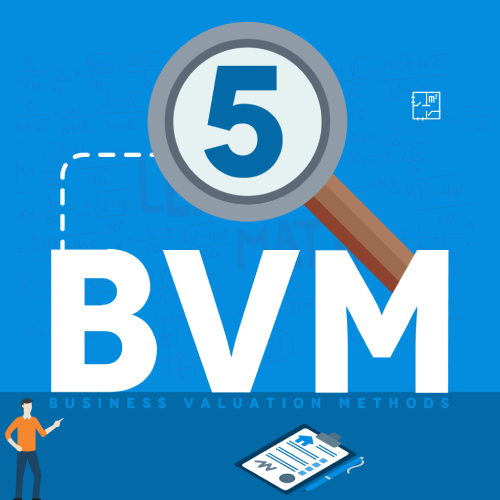- 1. Discounted Cash flow analysis (DCF)
- 2. Earnings before Interest, Taxes, Depreciation and Amortization (EBITDA)
- 3. Book Value
- 4. Market Capitalization
- 5. Real Option Analysis
- Factors Affecting Valuation
- The Bottom Line
"What is the worth of a company?" is the question every financial analyst and investor needs to answer to be on the safe side. Every person who ever studied finance must have encountered this question on their finance assignments. Company valuation involves assessing the total economic value of any given business and its assets. Thankfully, there are a plethora of techniques used to value a business.
This article discusses 6 of the most effective and commonly used business valuation methods. Luckily, you don't have to master all of them. Most experts usually just settle for two, whereby one is meant to confirm the other. Mastering more of them decreases your chances of overpaying for assets. Here we go.

1. Discounted Cash flow analysis (DCF)
.webp)
This is an intrinsic value approach where the analyst estimates the current value of a company using cash flows it is expected to generate in the future. It calculates the present value of future cash flows based on a specified discount rate and the period of analysis. The formula for discounted cash flow involves all future cash flows of a company.
If the discounted cash flow value is above the business's current investment cost, it could yield better returns to the investors. Analysts incorporate the weighted average cost of capital (WACC) for the discount rate to make it more accurate. This has the advantage of taking into consideration the rate of return that the shareholders expect.
2. Earnings before Interest, Taxes, Depreciation and Amortization (EBITDA)
EBITDA is one of the most straightforward values to calculate because the information needed is always available in a company's income statement and balance sheet. It is essentially the net earnings of a business with all the interest, amortization, taxes, and depreciation added back. It's a perfect valuation method that can be used to compare profitability among various companies because it doesn't include the effects of financing as well as capital expenditures.
The significance of adding interest expenses and income is to neutralize the cost of debt and the effect of interest payments on taxes paid by the business. While most managers prefer to talk about their EBITDA value when their net income isn't impressive, it's not malicious market trickery, but investors must be careful as it can misinform them about the business's financial performance and risks.
3. Book Value
Also known as the liquidation value, the book value of a business is the net amount that the business would generate if all of its liabilities are paid off and all assets liquidated at the moment. Warren Buffet, one of the most popular business investors, claims to have always used the book value to determine if a business is overvalued in the stock market. Based on this, it is always touted to be accurate at revealing the margin of error whenever doing a valuation.
The book value of a company has a very simple logic: if a company's sales fall dramatically after an acquisition, it can fall back on the book value. Therefore, it does not include intangible assets like brand recognition, goodwill, and intellectual property. Many investors will always assess the liquidation value of a company to know how much of their funds will not get lost in the event of bankruptcy.
4. Market Capitalization
This is yet another simple measure of the value of a publicly traded company. It's determined by finding a product of the total number of shares and the current share price. For example, a company with 18 million shares each worth £45 has a market cap of 810,000,000. The formula simply goes:
The market capitalization value helps investors to understand the size of one company as compared to another. It also reflects what investors are willing to pay for the company's stock, giving an idea about its future value. One disadvantage of the market cap is that it usually only takes to account the business's equity value despite most businesses being financed by both debt and equity.
5. Real Option Analysis
A real option gives a business the right but not obligation to undertake some business opportunities. Real option analysis is based on the logic that a business is nothing about a collection of real options. Such options may include the option to hire more staff, the option to make use of spare capacity, the option to invest in opportunities or pay opportunity costs, et cetera. Bringing together these options is what makes this type of valuation a success.
Since it doesn't involve any real cash flows, this valuation method is very effective for businesses without certain futures, for example, those that haven't started generating cash flows like startups. However, the relevance of real options is limited due to organizational, market, and technical considerations, for example, demand.
Factors Affecting Valuation
There are several factors that analysts may attempt to quantify but later have consequences on their buying decision. Due to this, investors may attempt to give a valuation range that takes care of the worst and best scenarios in the case of low-end and high-end valuations, respectively. Unquantifiable factors may include the following:
- Current market conditions
- Current economic climate
- The need for a quick sale by the seller
- All strategic gains that the buyer may gain
- The willingness of the seller

The Bottom Line
All valuation models are as useful as the factors involved. Our best advice for investors (and sellers) is to use many valuation methods as they can before agreeing on the final value of a company. While this may need more data and work, it's completely worth the resources and effort. Good luck!